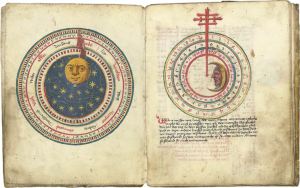So, several times over the last few months I’ve seen threads asking for advice on how to build desert/Arabian Nights style settings. Seeing as this is a field I am interested in and makes up a large part of what the Arcane Realm is based on on, I thought I’d post a starter kit of sorts.
This is going to be the first of a series giving overviews about recognizable aspects of Middle Eastern Fantasy (because do we need yet another medieval western Europe fantasy?)
Understand that the following is by no means comprehensive. It is intended merely to be a collection of ideas from myth, legend, and traditions that might jog your imagination.
I’m mainly going to focus on 1001 Nights sort of stuff. We’ll start with djinn. If you’re in a TL;DR mood, now’s the time to leave.
Jinni
The traditional view of djinn as individuals is that they are like humans, but have very poor impulse control. Being made of fire, they’re supposed to be as mercurial, dangerous, and unpredictable as fire is. Consequently they get bored with things very quickly, and sometimes fail to properly think through their actions. There are many stories of djinn falling in love with humans, but failing to realize how destructive their affections can be.
As for their society, it is more or less like ours. Djinn can be good or bad (though even the good ones can be dangerous and unpredictable). Often in folklore “good” is associated with “has converted to Islam,” but the point stands that they can choose to be good or bad, and even that they can choose their religion. The idea of “good” djinn usually involves them realizing how destructive their nature can be and consciously attempting to practice self-control, with varying degrees of success.
One thing you may have seen is references to different classifications of djinn. In D&D, for example, they are regularly divided amongst the elements, with djinn being associated with air, ifrit with fire, and marids with water. This has little to do with actual folklore. All djinn were thought to be made of “smokeless fire,” while mankind was made from (depending on the source) mud or clay. In the folklore these terms have different meanings. A “marid” is merely an exceptionally strong and powerful djinni. The term for malicious djinn is usually “shaitan,” though “ifrit” is sometimes used in this way as well. Ifrit, however, has other connotations, which I will mention later.
What precisely djinn can do is rarely spelled out in the Arabian Nights, but then the stories don’t go into much detail in general. This is because they are folktales, and folktales often are light on details because they are really just the skeletons of a story, a summary provided for the storyteller, who will creatively inject his own details.
So what can djinn do? Well, if you pay attention, they usually display the same powers in their stories: flight, invisibility, great strength, possession, and shape-shifting. “Wishes” are based less on djinn conjuring something from nothing (a power reserved for god) and more on the idea that they used these aforementioned skills. For example, Islamic tradition has it that King Solomon commanded the djinn and ordered them to build the great temple of Jerusalem. They had to actually assemble it, not just make it appear, but due to their powers they could assemble it very quickly. The djinni in the original version of Aladdin does the same thing when ordered to construct a palace.
If you order a djinni to do something too complex for him to accomplish, he may call up his family members or friends to assist him. He may also just bully lesser djinn into it. If you order a djinni to make you rich, he may give you some of the vast treasures he has accumulated over his long lifetime (in stories djinn often guarded hidden treasure caches) or he may simply take the riches you desire from somewhere else. The point is, djinn can’t just pluck whatever you want out of the ether. They have to find it and bring it to you. This can lead to complications, especially if the mountain of gold they just gave you came from the local sultan’s treasury.


